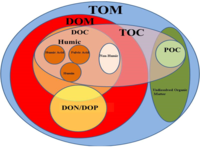
Photo from wikipedia
The degree to which climate warming will stimulate soil organic carbon (SOC) losses via heterotrophic respiration remains uncertain, in part because different or even opposite microbial physiology and temperature relationships… Click to show full abstract
The degree to which climate warming will stimulate soil organic carbon (SOC) losses via heterotrophic respiration remains uncertain, in part because different or even opposite microbial physiology and temperature relationships have been proposed in SOC models. We incorporated competing microbial carbon use efficiency (CUE)-mean annual temperature (MAT) and enzyme kinetic-MAT relationships into SOC models, and compared the simulated mass-specific soil heterotrophic respiration rates with multiple published datasets of measured respiration. The measured data included 110 dryland soils globally distributed, and two continental to global-scale cross-biome datasets. Model-data comparisons suggested that a positive CUE-MAT relationship best predicts the measured mass-specific soil heterotrophic respiration rates in soils distributed globally. These results are robust when considering models of increasing complexity and competing mechanisms driving soil heterotrophic respiration-MAT relationships (e.g., carbon substrate availability). Our findings suggest that a warmer climate selects for microbial communities with higher CUE, as opposed to the often hypothesized reductions in CUE by warming based on soil laboratory assays. Our results help to build the impetus for, and confidence in, including microbial mechanisms in soil biogeochemical models used to forecast changes in global soil carbon stocks in response to warming. This article is protected by copyright. All rights reserved.
Journal Title: Global change biology
Year Published: 2019
Link to full text (if available)
Share on Social Media: Sign Up to like & get
recommendations!